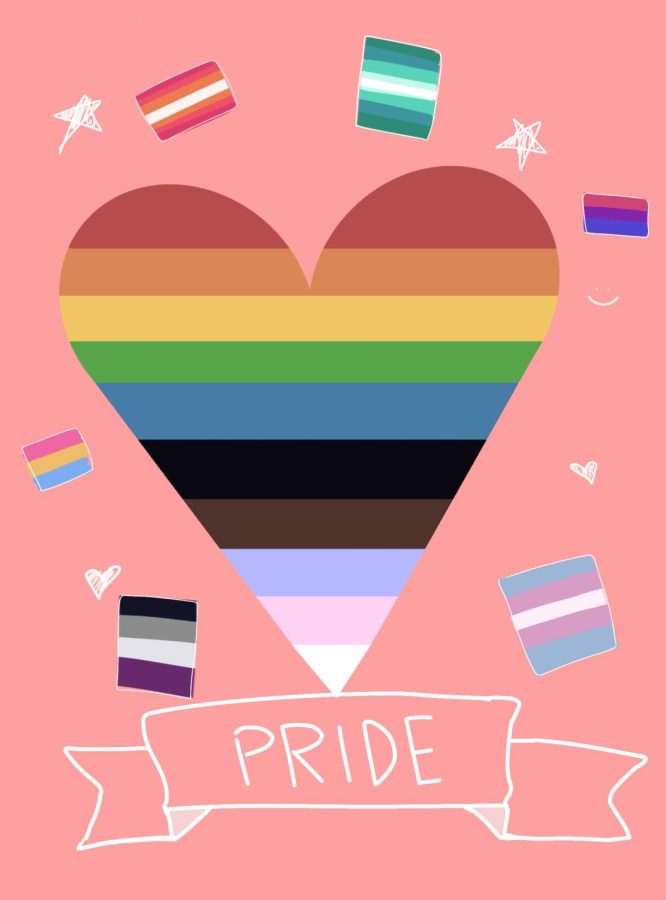The Past, Present, and Future of Pride Month
June 3, 2022
The month of June is largely uneventful other than being the beginning of summer and containing the last few weeks of school. However, an infinitely more important event is taking place right now, Pride. Pride, as defined by dictionary.com, is “a month-long observance in celebration of lesbian, gay, bisexual, transgender, and queer people — and the history, culture, and contributions of these people and their communities” (dictionary.com).
Even though Pride is way more than just a party, the most well-known events of the month are the parades and various festivals. It wasn’t always this way though, as the original Pride started out as a protest. According to ET Online, “June 28, 1969, marks the start of the Stonewall riots in which the queer community responded to a police raid that began at the Stonewall Inn… that served as a safe haven for the city’s gay, lesbian and transgender community.” Although this wasn’t officially the beginning of Pride, it is the catalyst that led to its creation (etonline.com).
Years later, Pride is largely a time for celebration, and the most common way to do this would be to attend a Pride parade. According to National Geographic, Pride parades date back to the Gay Liberation March that took place on the first anniversary of the stonewall riots. This march was groundbreaking, especially because being publicly LGBTQ was illegal back then. It largely took place in New York but smaller marches also took place in San Francisco and Los Angeles on the same day. These marches paved the way for the Pride Month we know today and fought back against anti-LGBTQ legislation (nationalgeographic.com).
The San Diego Pride Parade is taking place on June 16 starting at 10 a.m. According to the San Diego Pride website, “The parade begins at the Hillcrest Pride Flag at University Ave. and Normal St., proceeds west on University Avenue, turns south on Sixth Avenue, turns left onto Balboa Drive and ends at Quince Drive.” The parade ends at the site of the Pride Festival, which occurs on both June 16 and 17 (sdpride.org).
Other than the parades and festivals, people can also celebrate Pride by waving colorful flags. The most commonly seen is the iconic rainbow flag created by Artist Gilbert Baker in 1978. According to ET Online, the colors on the rainbow flag each have an individual meaning: red means life, orange means healing, yellow means sunlight, green means nature, indigo means serenity, and violet means spirit. Although the rainbow flag is the most common, it is important not to forget about the numerous other flags representing the various sexualities and gender identities that are part of the LGBTQ community (etonline.com).
Other than the parades and learning the history of Pride, the best way to celebrate it would be to support the LGBTQ people around you, and the GSA (Gay-Straight Alliance) club here on campus is one such way to do that. Joining, whether this year or the next, is a good way to start or continue supporting your LGBTQ classmates. They meet every Thursday during lunch in room 214, according to the UCHS website (uchs.sandiegounified.org). Another way you could celebrate Pride would be to donate to LGBTQ charities such as The Trevor Project, Human Rights Campaign Foundation, The Point Foundation, SAGE, and GLSEN (moneygeek.com).
Sophomore Clay Shaughnessy, who is the president of UC High’s GSA club, underlined the importance of celebrating Pride Month. “[Pride] is also a time to remember the important people like Harvey Milk, Sylvia Rivera, and Marsha P. Johnson who fought for the rights we have today,” he said. “…it is so incredibly important to take this month of remembrance and educate yourself on queer history, queer lives, and queer rights,” he added.
Pride is an influential and beautiful month-long celebration that commemorates and remembers the history and people part of the LGBTQ community. The struggles that led to the Pride Month we know today are never over, and there is always someone to support during Pride, no matter who you are.


